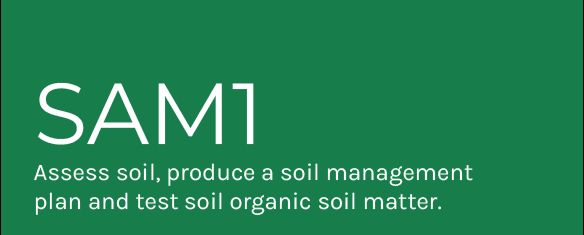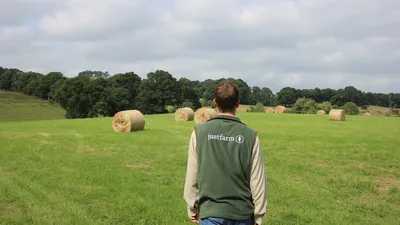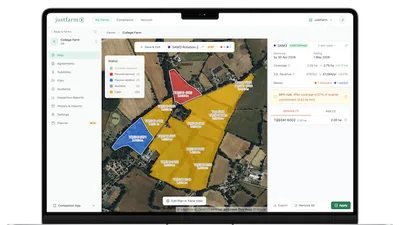SAM1 - Assess soil, produce a soil management plan and test soil organic matter
Payment
You will receive £6.00 per hectare and £97 per SFI agreement per year.
Aim
This action aims to help you:
- Understand the condition of your soil.
- Effectively plan to increase the long-term health, productivity, and resilience of your soil.
Where to Apply This Action
This action is applicable on eligible agricultural land located below the moorland line.
Table 3: Eligible Land for SAM1
| Eligible Land Type | Eligible Land Use Code | Compatible Land Cover |
|---|---|---|
| Arable land, including temporary grassland | Arable crops | Arable land |
| Leguminous and nitrogen-fixing crops | Arable land | |
| FA01 | Arable land | |
| TG01 | Arable land | |
| Permanent crops – horticultural and non-horticultural | Permanent crops | Permanent crops |
| Permanent grassland – improved and low input | PG01 | Permanent grassland |
The glossary (annex C) explains land types, land use codes, and compatible land covers.
The 'SFI available area' for each land parcel will be calculated automatically by the SFI application service. You must verify that this area is eligible. Refer to section 4.1.2 for more information about how the SFI available area is calculated.
You must apply this action to the total SFI available area of each land parcel. You cannot apply it to only part of that area. This action is static and must be applied to the same eligible area for each year of your 3-year SFI agreement.
Compatible Actions and Options
Table 4: Actions or Options that can be located on the same area as SAM1
| Scheme | Action or Option Codes |
|---|---|
| SFI 2023 | All SFI actions, except MOR1 |
| CS |
Arable CS options: AB1, AB2, AB3, AB4, AB5, AB6, AB7, AB8, AB9, AB10, AB11, AB12, AB13, AB14, AB15, AB16 In-field tree CS options: BE1, BE2 Traditional orchard CS options: BE4, BE5 Grassland CS options: GS1, GS2, GS3, GS4, GS5, GS6, GS7, GS8, GS9, GS10, GS11, GS12, GS13, GS14 Historic environment CS options: HS3, HS4, HS7, HS9 Lowland heathland CS options: CT1, CT2, CT3, CT4, CT5, CT7, LH1, LH2, LH3, WT6, WT7, WT8, WT9, WT10 Organic CS options: OP1, OP2, OP3, OP4, OP5, OR1, OR2, OR3, OR4, OR5, OT1, OT2, OT3, OT4, OT5 Water quality CS options: SW1, SW2, SW3, SW4, SW5, SW6, SW7, SW8, SW9, SW10, SW12, SW13, SW15, SW16, SW17, SW18, WT1, WT2 Uplands CS options: UP2 (if located below the moorland line) |
| ES | All ES revenue options |
| SFI pilot | SFI pilot arable and horticultural land standard – all levels SFI pilot improved grassland standard – all levels SFI pilot low and no input grassland standard – all levels SFI pilot water body buffering standard – all levels SFI pilot hedgerows standard – all levels |
Use the CS grant finder to search for CS option codes.
SFI actions for hedgerows (HRW1, HRW2 and HRW3) and CS option BE3 can be done on the eligible boundaries of a land parcel entered into SAM1.
If an action or option cannot be located on the same area as SAM1, it is either due to ineligible land type, incompatible activities, or double payment. The area will be removed from the SFI available area.
Refer to section 4.2 for information about land eligibility for other schemes and funding sources.
What You Must Do
You must:
- Assess the soil for all land parcels and produce a written soil management plan.
- Test the soil organic matter (SOM) on all land parcels within the last 5 years.
If you have a soil management plan written within the last 12 months based on a soil assessment, or existing SOM test results no more than 5 years old, these can be used.
Small land parcels with similar soil and management can be combined for a single SOM test sample.
Historic or Archaeological Features
If you need to take soil samples on land with historic or archaeological features:
- Request an SFI Historic Environment Farm Environment Record (SFI HEFER), explained in section 4.3.2.
- Meet the requirements for taking soil samples on these areas, explained in section 4.3.2.
You may be asked to provide information about soil assessment and SOM testing results. This data helps improve national soil data and aligns with government soil policy. Guidance on how to provide this information will be on GOV.UK.
When to Do It
Soil Assessment and Soil Management Plan
- Complete the soil assessment and plan within the first 12 months of your SFI agreement.
- Review the soil management plan each subsequent year of your 3-year agreement, and add any new soil analyses.
SOM Testing
- Ensure SOM has been tested on all land parcels entered into this action within the last 5 years each year of your agreement.
- Retest land if SOM test results reach 5 years old.
If the timing aligns, you can complete SOM testing with routine soil testing required by the farming rules for water.
If land entered has not been tested within the last 5 years, try to do SOM testing during the first 12 months of your agreement.
If laboratory capacity is limited:
- Get the tests done as soon as possible.
- Ensure all land parcels have SOM tested within the last 5 years by the end of the SFI agreement.
- Keep evidence of why tests were not completed in the first 12 months.
How to Do It
The method of completing this action is up to you, provided it achieves the action’s aim.
Voluntary guidance on how to assess soil, create a plan and test SOM may be helpful, but is not mandatory. You can record the plan on paper or digitally.
Evidence to Keep
You must keep:
- The written record of your soil management plan, including your soil assessment.
- The SOM test results.
You must supply this evidence when requested.
Contains public sector information licensed under the Open Government Licence v3.0. Source: SFI Handbook for the SFI 2023 Offer




